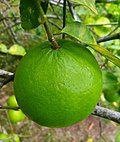Key lime
Key Lime (Citrus aurantifolia) is a citrus species with a round fruit, 2.5–5 cm in diameter (1–2 in), that is yellow when ripe but usually picked green commercially. It is smaller, seedier, has a higher acidity, a stronger aroma, and a thinner rind than that of the Persian lime (Citrus x latifolia). It is valued for its unique flavor compared to other limes, with the key lime usually having a more tart and bitter flavor.
History[edit]
The Key lime is thought to be a hybrid of the micrantha lime (Citrus micrantha) and the citron (Citrus medica), both species introduced to the Americas by the Spanish explorers. Key lime is an integral part of the flora in the Florida Keys, hence the name.
Cultivation[edit]
Key limes are propagated from cuttings, with the tree being about 5 m (16 ft) high and with many thorny branches. The leaves are ovate 2.5–9 cm (1–3.5 in) long, resembling orange leaves. The flowers are 2.5 cm (1 in) in diameter, are yellowish white with a light purple tinge on the margins. Key limes are very cold-sensitive and are thus a predominant crop only in warm climates; they are naturalized in coastal areas of Texas, Mexico, and the Caribbean.
Uses[edit]
Key limes are used in a variety of products, including Key lime pie, cocktails, marinades, and salad dressings. The juice of the Key lime is highly acidic and has a strong, distinctive smell. The peel of the fruit has a unique aroma due to its limonene content.
See also[edit]
Key lime[edit]
-
Lime 01
-
A tree full of key limes in West Bengal, India
-
Map of inferred original wild ranges of the main Citrus cultivars, and selected relevant wild taxa (Fuller et al., 2017)
-
Dayap or Philippine keylime
-
Keylime flower
-
KeyLime 2010 07 25 0001
-
Starr 080610-8303 Citrus aurantiifolia
Ad. Transform your life with W8MD's Budget GLP-1 injections from $75


W8MD offers a medical weight loss program to lose weight in Philadelphia. Our physician-supervised medical weight loss provides:
- Weight loss injections in NYC (generic and brand names):
- Zepbound / Mounjaro, Wegovy / Ozempic, Saxenda
- Most insurances accepted or discounted self-pay rates. We will obtain insurance prior authorizations if needed.
- Generic GLP1 weight loss injections from $75 for the starting dose.
- Also offer prescription weight loss medications including Phentermine, Qsymia, Diethylpropion, Contrave etc.
NYC weight loss doctor appointmentsNYC weight loss doctor appointments
Start your NYC weight loss journey today at our NYC medical weight loss and Philadelphia medical weight loss clinics.
- Call 718-946-5500 to lose weight in NYC or for medical weight loss in Philadelphia 215-676-2334.
- Tags:NYC medical weight loss, Philadelphia lose weight Zepbound NYC, Budget GLP1 weight loss injections, Wegovy Philadelphia, Wegovy NYC, Philadelphia medical weight loss, Brookly weight loss and Wegovy NYC
|
WikiMD's Wellness Encyclopedia |
| Let Food Be Thy Medicine Medicine Thy Food - Hippocrates |
Medical Disclaimer: WikiMD is not a substitute for professional medical advice. The information on WikiMD is provided as an information resource only, may be incorrect, outdated or misleading, and is not to be used or relied on for any diagnostic or treatment purposes. Please consult your health care provider before making any healthcare decisions or for guidance about a specific medical condition. WikiMD expressly disclaims responsibility, and shall have no liability, for any damages, loss, injury, or liability whatsoever suffered as a result of your reliance on the information contained in this site. By visiting this site you agree to the foregoing terms and conditions, which may from time to time be changed or supplemented by WikiMD. If you do not agree to the foregoing terms and conditions, you should not enter or use this site. See full disclaimer.
Credits:Most images are courtesy of Wikimedia commons, and templates, categories Wikipedia, licensed under CC BY SA or similar.
Translate this page: - East Asian
中文,
日本,
한국어,
South Asian
हिन्दी,
தமிழ்,
తెలుగు,
Urdu,
ಕನ್ನಡ,
Southeast Asian
Indonesian,
Vietnamese,
Thai,
မြန်မာဘာသာ,
বাংলা
European
español,
Deutsch,
français,
Greek,
português do Brasil,
polski,
română,
русский,
Nederlands,
norsk,
svenska,
suomi,
Italian
Middle Eastern & African
عربى,
Turkish,
Persian,
Hebrew,
Afrikaans,
isiZulu,
Kiswahili,
Other
Bulgarian,
Hungarian,
Czech,
Swedish,
മലയാളം,
मराठी,
ਪੰਜਾਬੀ,
ગુજરાતી,
Portuguese,
Ukrainian







